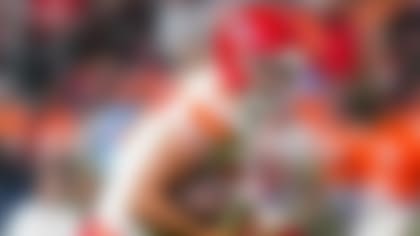Helmet-to-helmet hits have dominated the NFL conversation over the past week. The league took action and, with a few severe fines and the threat of suspensions, things looked a lot safer in Week 7. Ray Anderson, the NFL executive vice president of football operations, even said as much in the aftermath of Sunday.
In examining hits delivered by James Harrison, Dunta Robinson and Brandon Meriweather -- which led to $175,000 in total fines -- many experts referenced page 83 in the NFL rule book to clarify the issues. But what we still need to understand is the many reasons why there is, and will still be, unnecessary roughness penalties.
First, this excerpt from the rule book (Rule 12, Section 2, Article 8h):
If a receiver has completed a catch and has not had time to protect himself, a defensive player is prohibited from launching (spring forward and upward) into him in a way that causes the defensive player's helmet, facemask, shoulder, or forearm to forcibly strike the receiver's head or neck area -- even if the initial contact of the defender's helmet, facemask, shoulder or forearm is lower than the receiver's neck.
Consider what position a defensive player has to be in to orchestrate such a collision. Chasing a receiver down the field in man-to-man coverage, rarely would a defender be in position to deliver such an illegal shot. But a defender -- be it a defensive back or linebacker -- lurking in zone coverage just waiting for the targeted offensive player to come his way, he finds himself in optimal position to square up his target and deliver a blow.
If you look at the penalized defenders in recent weeks, most of them occurred in zone defenses. While there are plenty of opportunities to deliver a legal shot in an attempt separate the receiver from the ball, illegal hits are bound to continue. If you look at personal fouls being called this year as compared to last year, the pace is still about the same. Not all personal fouls are for illegal hits on a defenseless receiver, but you still get a sense of what is happening.
Let's take a look at the well-advertised Cover 2 and show you why defensive players in this scheme are in great position to collide with a receiver.
(Diagram 1): There are five underneath defenders splitting the field in coverage zones and two more splitting the deep part of the field in half. There are nuances to the coverage, which I will explain later, but the basic premise in this coverage is that all seven defenders are looking at the quarterback and gaining depth in their zone boxes to attack the receiver who comes into their area. The corners are not turning their backs to the QB and running vertically. They are funneling the receivers inside towards the safeties with an eye on a second receiver coming into their zones. By funneling the receiver inside, if the wideout wants to run a quick slant, the strong-side linebacker or the nickel back has a clean shot to collide with the receiver.
(Diagram 2): One of the most popular routes these days is the "shallow cross," and it is the subject of many of the illegal hits on receivers. It can be run by a wideout or tight end, and it involves crossing the field at a depth of about 10 yards. The coaching point to the player executing the shallow cross is if there is man-to-man coverage, keep running away from the defender and look for the ball on the upfield shoulder.
(Diagram 3A): If it's zone coverage, the receiver must look for the open space between the linebacker and corner and "sit down." It's amazing to me how dangerous this route has become because the receiver and the QB aren't always on the same page. The QB has to know when the receiver doesn't recognize the difference between man and zone, which means he either leads the wideout into the collision or has to throw elsewhere.
(Diagram 3B): I discussed the "shallow cross" with three people who know it well: Hall of Fame QB Dan Marino, Dolphins WR Davone Bess, and Ravens WR T.J. Houshmandzadeh. Bess and Houshmandzadeh both run this route a lot and feel the receiver deserves what he gets if he doesn't "sit down" in the open area. The space between the strong-side LB drop and the CB drop is the open spot, and Bess and Houshmandzadeh have nearly perfected ways of finding it in zone coverage and catching the ball. The problem arises when the receiver doesn't recognize the spot and continues through the zone. The QB throws it to him, and the CB is waiting to level the receiver.
(Diagram 4): The next area that provides devastating hits on receivers in the Cover 2 scheme is the "seam route." Whether it's the tight end or the wide receivers going vertical, the underneath zone defenders are going to carry the seam route to the back of their zone before passing him off to the safeties. Zone defenses are very aware of not leaving gaping holes in the coverage behind the underneath zone droppers and in front of the safeties. Not every QB can "drop" the ball in this tight window and trouble comes when the passer tries to finesse the ball in, giving the safety time to deliver the devastating shot.
I'm not suggesting zone coverages are dangerous or should be outlawed, but offensive players and coaches have to recognize some routes are taken away by zone coverages. Defensive backs and linebackers that play a lot of the Cover 2 scheme can read patterns. When combining that information with down-and-distance tips, personnel groups and tendencies, defenders can sit in zones and wait for the action to come to them. And when that happens, there are going to be some significant collisions.



